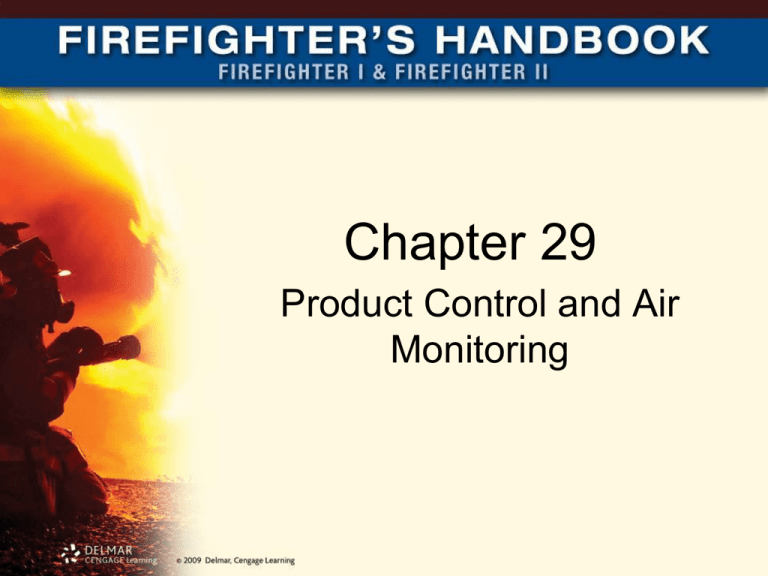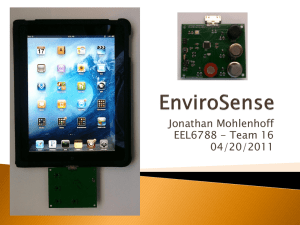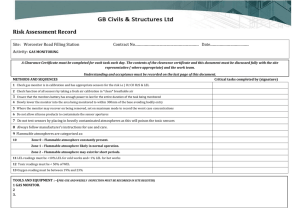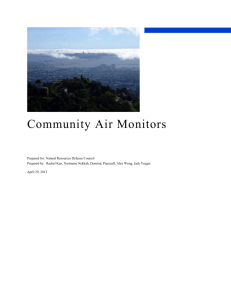Chapter 29
advertisement

Chapter 29 Product Control and Air Monitoring Introduction • Product control techniques can provide quick reduction in damage • Reduction of surface area reduces danger to responders and community • Use of air monitoring devices is becoming more commonplace • To ensure firefighter safety, basic air monitoring must be accomplished 29.2 Defensive Operations • According to NFPA, three large tasks fit into operations-level tactical response: – Basic air monitoring – Containment – Confinement • Type and level of PPE for each task will vary with chemical involved 29.3 Absorption • First responders often asked to clean up spilled material • Absorption commonly used for fuel and oil products • Know type of absorption material carried on apparatus • Filter fences hold absorbent material 29.4 A screen fence can be used to collect the absorbent material floating on the water after the absorbent has collected the spilled material. The water flows through the fence below the absorbent. 29.5 Diking and Damming • Quantity of material spilled determines extent of diking and damming operations performed • Use earth, sand, or rocks for dikes or dams • Local or state highway departments are a good source for materials • Do not set barrier too close to spill • Two basic dams – Overflow – Underflow 29.6 The overflow dam allows the clean water to flow over the dam and collects the spilled material at the base of the dam. The underflow dam collects the spilled material on top and allows the water to flow through the bottom of the dam. 29.7 Overflow dam. Underflow dam. 29.8 Diverting • Almost anything can be used • Keep a running spill from entering a storm drain • Can be used for spills on water • Dig trench alongside waterway to collect spilled material 29.9 Retention • Most common method is digging a hole • Creating a large enough containment area is paramount to success • If one large area cannot be dug, dig several smaller holes in a row 29.10 Building a retention area is a good method for holding released products. Retention areas can be dug from existing earth or created with truckloads of sand or dirt. Small holding areas can be hand dug, but for larger spills heavy equipment is required. 29.11 Dilution • Not always the solution for pollution • Flushing of material into waterway is not acceptable • Dilution may work when combined with other containment tactics 29.12 Vapor Dispersion • Material that is being released must be water soluble • Not recommended unless a life threat exists • Water at natural gas leaks further complicates repair • Use of water can also result in creation of another substance 29.13 Vapor Suppression • With use of firefighting foam • Type of material spilled dictates the type of foam • Before application of foam, responders should ensure material is contained 29.14 Remote Shutoffs • Not usually a tactic used by first responders • Remote shutoffs could be operated by first responders • Usually well marked as emergency shutoffs 29.15 Air Monitoring at the First Responder Operations Level • Air monitoring is one of the most important tasks to accomplish – pH detection – Combustible gas detector – Photoionization detector (PID) • Most fire service responders have reasonable understanding of combustible gas indicators 29.16 First responders commonly use devices that detect the presence of flammable gases, carbon monoxide, and hydrogen sulfide and determine the oxygen content. This detector also detects the presence of common toxic vapors. 29.17 Regulations and Standards • HAZWOPER regulation does not provide a lot of specific requirements for air monitoring • NFPA 472 is fairly generic • Important for first responders to understand how monitors work 29.18 Air Monitor Configurations • Most departments purchase a three-, four-, or five-gas instrument • Also called a multi-gas detector • Inexpensive compared to other detection devices used by hazardous material team • Sensors need replacement • Problems created by lack of maintenance and adequate training 29.19 Meter Terminology • Responder must understand basic terminology that is generic to all monitors – – – – – Bump test Calibration Reaction time Recovery time Relative response 29.20 Bump Test • Exposes a monitor to known gases, allowing the monitor to go into alarm mode • Most manufacturers provide bump gas cylinders • Used to ensure that alarms function and instrument is reading 29.21 Calibration • Determine if monitor responds accurately to exposure to a known quantity of gas • When new sensors are installed, monitor should be calibrated • Regularity of calibration is subject to great debate 29.22 Calibration involves exposing the instrument on the right to a known quantity of gases to ensure that it is reading the gases correctly. This kit calibrates the monitor with a variety of gases. 29.23 Reaction Time • All monitors have a lag time, better known as reaction time • Monitors operating without a pump are in diffusion mode – Will have 15- to 30-second lag time • Monitors operating with a pump have reaction time of 7 to 30 seconds • WMD detection devices may take up to 90 seconds to react 29.24 Recovery Time • Recovery time is the amount of time it takes the monitor to clear itself of air sample • Affected by: – Chemical and physical properties of sample – Amount of sampling hose – Amount absorbed by monitor • Sometimes instrument must be taken out of environment and restarted • Reaction time affects overall recovery time 29.25 Relative Response • When gas monitor is purchased, it is set to read a specific type of gas • Relative response describes the way monitor reacts to gas other than the one it was calibrated for • Each person operating an air monitor must have a basic knowledge of relative response • Actual LEL reading = Detector reading Response curve factor 29.26 Correction Factors (Calibrated to Pentane)a 29.27 Oxygen Monitors • Oxygen: one of most important things to sample • Normal air contains 20.9 percent oxygen – Below 19.5 considered a health risk – Above 23.5 considered a fire risk • Oxygen-enriched atmospheres result from a chemical reaction involving oxidizers • Temperature below 0°F can permanently damage the sensor • Requires calibration at pressure of sample 29.28 Flammable Gas Indicators • All of these types of sensors work, some better than others in different situations – Catalytic bead sensor – Metal oxide sensor – Infrared sensor • Most FGIs read up to the LEL of the gas – Longer the exposure is above the LEL, the quicker it loses its life • Any flammable gas will cause a reaction in the sensor 29.29 Examples of flammable gas indicators: catalytic bead, metal oxide, and infrared. 29.30 Toxic Gas Monitors • Sensors commonly used in multi-gas monitors – Also usually used to measure CO and H2S • Toxic sensors are available for a variety of gases • Most toxic sensors are electrochemical sensors – Have electrodes and a chemical mixture sealed in a sensor housing • Gas passes over the sensor, causing chemical reaction, creating electrical charge • Toxic sensors display parts per million 29.31 Tactical Use of Multi-Gas Detection Devices • MOS sensors react quickly and detect low levels of flammable gas – Not accurate, fluctuate considerably – Detect water vapor and give erroneous readings • Catalytic bead and infrared both are accurate • Most flammable gas detectors only read methane accurately • When LEL sensor alarms at 10 percent level for an unidentified material, they should retreat 29.32 Other Detectors • Following detectors are used by a hazardous materials team, but should be understood by first responder – – – – – Photoionization detectors Radiation pagers Colorimetric tubes Chip measurement system Air monitoring equipment 29.33 Using Air Monitoring Equipment • Ensure battery level and bump test the instrument • Understand what the flammable gas sensor detects and what it does not detect • The oxygen sensor indicates the level of oxygen • Understand the alarm levels for the instrument being used 29.34 Carbon Monoxide Incidents • 40,000 people treated for carbon monoxide poisoning each year • SCBA functioning when rescuing residents • On arrival, fire service monitors will not read CO even if present in dangerous concentrations • Brand and type of CO detector determines performance – Biomimetic – Metal oxide – Electrochemical 29.35 Biomimetic • Gel-like material • Prone to false alarms • May need 24 to 48 hours to clear itself 29.36 Metal Oxide • Same type of sensor used in combustible gas detector • Has cross sensitivities and reacts to other gases • Responders could be walking into a flammable atmosphere • Requires a lot of energy, provides a digital readout • Clears in less than 24 hours 29.37 Electrochemical • Also referred to as an instant detection and response sensor • Two charged poles in a chemical slurry – CO causes a chemical reaction – Changes the resistance within the housing • Provides an instant reading of CO – Internal mechanism that checks the sensor • Provides the best sensing capability 29.38 Lessons Learned • Defensive product control is a key component • First responders have equipment necessary to handle these tasks • Limiting spill will mitigate incident sooner • First responders are becoming more involved with air monitoring • Understanding action levels are an important consideration for safety 29.39









